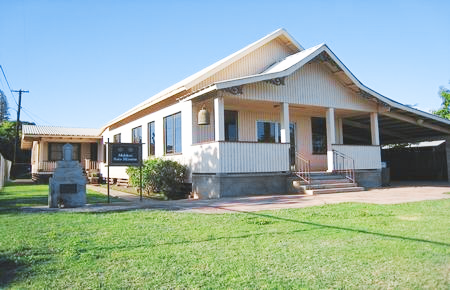
Craig Gima
Like many of the plantation-era Japanese Buddhist temples in Hawai’i, the Guzeiji Soto Mission of Molokai has struggled to find relevance and purpose as membership died off and the children of members moved away and assimilated into other religions. The temple’s membership of more than 100 in the 1960s has dwindled to less than 20 mostly older parishioners today.
“The mission of our church is to help the community. Whatever the community needs, the church tries to help in some way,” said Lisa Takata, president of the Molokai Soto Mission.
When it was founded more than a century ago, during the height of Japanese immigration to Hawai’i, the temple provided a sense of community and a gathering place for the Japanese men who worked the pineapple fields and later for their families, according to Takata.
When the Covid-19 pandemic hit, a minister who flew in quarterly from Oahu to hold services couldn’t come. The annual Obon dance, the temple’s biggest event, which attracted people of all races and religions, was canceled, and the temple sat mostly idle.

Guzeiji Soto Mission of Molokai (Photo: Courtesy of AARP)
But things are happening again at the Soto Mission, thanks in part to a $11,500 AARP Livable Communities 2022 Community Challenge Grant. The grant paid for a Wi-Fi hotspot at the mission, which is used to host tech classes for kupuna (elders). Other grants, awarded with the help of the Krause Family foundation ‘Alana Ke Aloha, helped pay for tables, benches and the beautification of public spaces at the mission.
Molokai, the second smallest of the major populated Hawaiian islands, is a rural community with a population of a little more than 7,000 residents. Cell coverage and internet access is spotty.
Even with the new hotspot, some of the older residents and parishioners still had difficulty going online because they didn’t know how to use their phones, tablets and other devices. That’s where the tech classes at the mission come in.
The classes are intergenerational — students from Molokai High School answer questions from kupuna about how to use their devices.
“As kupuna, we are often filled with fear about trying new things on our equipment for fear of the ‘unknown,’” said Mary Kalilikane, one of the kupuna in the class, in an email. “What if we get into something we don’t want or the dark web or do something that will make our phone inoperable?”
Some kupuna learned how to Facetime so they could keep in touch with family who’ve moved away.
“It’s different when you are just talking to someone on the phone and now you can see them. They’re showing them grandbabies,” Takata said. “When they can Facetime family, I think that’s a big thing. They (their children) are like, ‘Wow mom, you’re Facetiming, what’s going on?’”
“Hopefully, the church can be a community space where people can come. The hotspot is already there, and people can learn all kinds of things,” Takata said. “We want to serve the community in whatever way we can.”
Craig Gima is the communications director for AARP Hawai’i.
2023 AARP Community Challenge Grants
What Is It? The AARP Livable Communities Initiative is giving grants to fund quick-action projects that help communities become great places to live for people of all ages. The grants range in size from several hundred dollars to tens of thousands of dollars for larger projects. AARP is looking for projects that improve public places; transportation; housing; diversity, equity and inclusion; digital connections; community resilience; civic engagement; and community health and economic empowerment.
Who Can Get Grants? Nonprofits and government entities with great ideas for fast-tracked projects can apply. A key element of the grants is that projects must be completed by Nov. 30.
What’s New This Year? We are offering $2,500 Capacity-Building Microgrants for projects that support walkability and community gardens. The grants come with webinars, one-on-one coaching and other learning opportunities for recipients. Also new are Demonstration Grants for projects that encourage replication of promising local efforts that build capacity for transportation system changes and accessory dwelling unit design competitions.
How Does My Organization Apply? Visit aarp.org/communitychallenge to learn more and apply.



